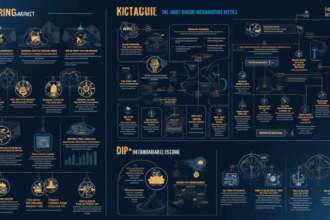Introduction
With an estimated loss of $4.1 billion due to DeFi hacks in 2024, the Bitcoin blockchain has faced scrutiny over its energy consumption and sustainability. As digital currencies continue to reshape the financial landscape, understanding their energy efficiency is more critical than ever. This article delves into the complexities surrounding the Bitcoin blockchain’s energy efficiency, offering insights, statistics, and future projections that will aid investors and users alike.
The Basics of Bitcoin Blockchain Energy Consumption
The Bitcoin blockchain, a decentralized digital ledger, relies on a network of nodes that validate transactions through a process called mining. This process is often criticized for its substantial energy requirements.
- In 2023, the Bitcoin network is estimated to consume 120 terawatt-hours (TWh) annually, comparable to the energy usage of entire countries.
- This energy consumption raises questions about the environmental impact of cryptocurrencies.
- As nations push for greener technologies, Bitcoin’s energy usage must be scrutinized through the lens of sustainability.
Understanding Energy Efficiency in Blockchain
To grasp how energy efficiency operates within the Bitcoin blockchain, one must understand the underlying consensus mechanism and its implications. Bitcoin employs a proof-of-work (PoW) model, which, while secure, demands extensive computational power.

- Mining Process: Miners utilize specialized hardware to solve complex mathematical problems, which necessitates vast amounts of electricity.
- Improved technologies in mining have shown promise in reducing energy footprints, with ASIC miners being significantly more efficient than older mining rigs.
- As a comparison, if Bitcoin were to shift to a proof-of-stake (PoS) model, energy consumption could potentially drop by over 90%.
The Role of Renewable Energy Sources
Renewable energy is becoming a vital part of the Bitcoin mining ecosystem. According to a study by the Cambridge Centre for Alternative Finance, about 39% of Bitcoin miners now utilize renewable energy sources.
- Hydropower: Regions rich in hydroelectric power, such as Sichuan in China, dominate the mining landscape due to affordable energy.
- Solar and Wind Power: Solar panels and wind turbines are gradually becoming more attractive options for miners, particularly in areas with favorable climates.
- This shift contributes to a more sustainable blockchain environment and aligns with global carbon-neutral goals.
Impact of Regulation on Energy Practices
As governments worldwide adopt regulations targeting cryptocurrency and energy consumption, understanding the legal landscape is crucial. Vietnam, for instance, has seen a surge in crypto investments, with an annual user growth rate of 30% in 2023. This rapid adoption calls for more robust energy practices.
- Compliance Requirements: Miners may face stricter regulations related to energy usage, forcing investments in more efficient technologies.
- Environmental Policies: Engaging with local governments in Vietnam can aid in developing sound energy strategies that benefit both the economy and the environment.
Evaluating Future Trends in Bitcoin Energy Efficiency
The future of Bitcoin blockchain energy efficiency is bright but challenges remain. As technology advances, miners will have to adapt.
- Technological Innovations: New mining hardware designs and cooling techniques are emerging, promising improved efficiency.
- Community Initiatives: Collaborations, like those seen in Ethereum’s transition to PoS, may encourage Bitcoin to explore alternative consensus strategies.
- The growth of educational resources on blockchain energy regulations could foster better practices within the mining industry.
Practical Considerations for Miners and Investors
For individuals and enterprises involved in cryptocurrency mining or investing, understanding energy efficiency is pivotal. Here are some recommendations:
- Consider investing in ASIC miners that emphasize lower energy consumption and higher hashrate efficiency.
- Evaluate mining operations based on their energy sources—those using renewable are more sustainable and may face less regulatory scrutiny.
- Stay informed on local regulations regarding crypto mining and adjust strategies accordingly.
- Leverage innovations and participate in forums dedicated to discussion around blockchain energy practices.
Conclusion
As the landscape of the Bitcoin blockchain evolves, the need for energy efficiency becomes paramount. Through a combination of technological advancements and regulatory compliance, the future of Bitcoin blockchain energy efficiency holds promise. Maintaining a balance between innovation and sustainability will ensure that the benefits of blockchain technology are realized without compromising our planet. For those interested in cryptocurrency and its future, staying informed about these developments is essential. Let’s embrace the potential of energy-efficient blockchain practices together.
For more insights into the world of cryptocurrency, get started with bitcryptodeposit today.
Author Bio
Dr. Nguyen Thanh, a respected authority in blockchain technologies and their environmental impacts, has published over 50 papers in the field and led the audit of renowned crypto projects. With a keen focus on sustainable blockchain practices, he is an advocate for integrating renewable energy in cryptocurrency operations.







